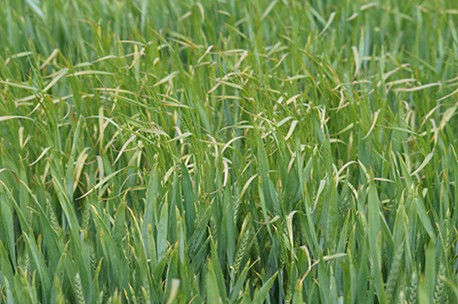Harnessing the power of TOWER® to banish brome
Brome has also become more difficult to control because of mounting resistance to ALS-inhibiting herbicides such as the sulfonylureas (e.g. metsulfuron) and triazolopyrimidines (e.g. flurosulam). As a result, growers can no longer rely on a single herbicide active ingredient to provide acceptable levels of control and should instead use a range of active ingredients to ensure infestations are kept in check.
About brome
Although brome is classified as a ‘very competitive’ weed (a population of 5 plants/m2 can reduce cereal yields by 5%), it has historically had a relatively limited impact on cereal yields as it has been confined to field margins, with any seeds that found their way further into the cropping area prevented from germinating by the burying action of ploughing.
However, with the increasing popularity of min-till and no-till establishment systems, brome populations have steadily migrated towards the centre of fields where their impact on cereal yield is much more significant.
This poses a serious threat to crop viability and value, not just because the vigorous growth habit of brome means it can cause yield reductions on a par with black-grass and ryegrass, but because ALS-inhibiting herbicides no longer provide effective control. Brome infestations can also hamper harvesting speed, putting additional pressure on workloads.
A robust sequence of pre-emergence and post-emergence herbicide treatments made up from a range of different active ingredients is therefore needed to provide effective control.
Mapping to understand the scale of the problem
The first step to understanding the extent and scale of brome infestations, is to identify which species are present, and to map their location(s) in each affected field. It also pays to have brome plants tested to determine if they are resistant to ALS-inhibiting herbicides so that an effective herbicide programme can be put in place.
The five main brome species commonly found UK arable crops:
1. Barren or sterile brome (Bromus sterilis)
Very common throughout England and Wales, more scattered in Scotland. Very common in field margins and hedgerows as well as within arable fields.
2. Soft brome (Bromus hordeaceus)
Very common throughout the UK. Most commonly found in grassland, field margins, waste ground and roadside verges, but also occurs in arable fields.
3. Great brome (Bromus diandrus)
Mainly found in East Anglia, but scattered throughout the rest of England.
4. Meadow brome (Bromus commutatus) taxonomically is now considered to be a variety of smooth brome (B. racemosus).
Mainly found in grassland situations, especially old pastures, but also occurs in arable fields.
5. Rye brome (Bromus secalinus)
Mainly found in scattered locations in the southern half of England. Largely confined to arable fields, field margins and waste ground.
(Source: Identification of Brome grasses, Dr Stephen Moss, Rothamsted Research.)
The power of TOWER®
In a NIAB trial carried out on behalf of ADAMA, TOWER® (40 g/l diflufenican, 300 g/l pendimethalin and 250 g/l chlorotoluron) was shown to boost the control of brome species when included as a tank mix partner at the post-emergence timing – see graph below.

TOWER’s efficacy versus sterile, meadow and rye brome (plus its activity against annual meadowgrass, broad-leaved weeds, ryegrass and groundsel) has also been confirmed in trials carried out by ADAS, with the same work also indicating that the level of control provided by TOWER® varies according to the species of brome being targeted and the timing of application.
For example, rye and sterile brome were shown to be the most susceptible to TOWER® when applied at the pre-emergence or early post-emergence (GS11-13) timings, while meadow brome is only susceptible to TOWER® when it is applied in combination with diflufenican at the pre-emergence timing, or when applied with prosulfocarb from pre-emergence through to tillering (GS21). The addition of prosulfocarb was also shown to improve control at all timings for all species of brome.
A tailored herbicide plan
As a result of the variation in response that each brome species exhibits, it is essential for growers to understand exactly which species they are dealing with. Only then can a tailored, field-by-field herbicide programme (which matches the growth stage of the crop, the germination phase of weeds, and the resistance status of the weed population) be put in place.
And with growers no longer able to rely on post-emergence ALS treatments to clean-up crops in the spring, these tailored, field-specific programmes should be based around a combination of pre-emergence treatments plus a subsequent top-up treatment at the early post-emergence timing.

Brome species are becoming more problematic in min-till systems where they can cause yield reductions on a par with black-grass and ryegrass.
TOWER®: an exclusive three-way co-formulation
TOWER® is an exclusive co-formulation of three active with complementary modes of action for optimal grass weed control and resistance management.
In addition to providing excellent control of annual meadow grass and broadleaved weeds, TOWER also provides good activity against grass weeds (including brome) in winter and spring wheat, winter and spring barley, winter rye and winter triticale.
Three active ingredients:
- 250 g/l chlorotoluron
- 40 g/l diflufenican
- 300 g/l pendimethalin
With a flexible product label, TOWER® can be used as a pre- and/or post-emergence treatment in winter cereals and spring wheat and spring barley.
For more information about which active ingredients TOWER can safely and effectively be used alongside, please visit the ADAMA Tank Mix Database at https://www.adama.com/uk/en/database-adamas-tank-mixes
BROME RESOURCES
Species identification
Use the following link to identify which species of brome are present on your land: https://ahdb.org.uk/knowledge-library/arable-weeds-which-brome-species-is-in-your-field
Resistance testing
To find out more about resistance testing go to https://projectblue.blob.core.windows.net/media/Default/Imported%20Publication%20Docs/AHDB%20Cereals%20&%20Oilseeds/Weeds/WRAG/WRAG%20Maximising%20the%20benefits%20of%20herbicide%20resistance%20testing%20(June%202020).pdf
Additional information
For more general information on the control of brome visit https://ahdb.org.uk/news/use-brome-maps-to-target-weed-control
Latest articles

A look at the next generation of cereal disease control - ADAMA In Action 2025

Powering up slug control: the importance of mould resistance

